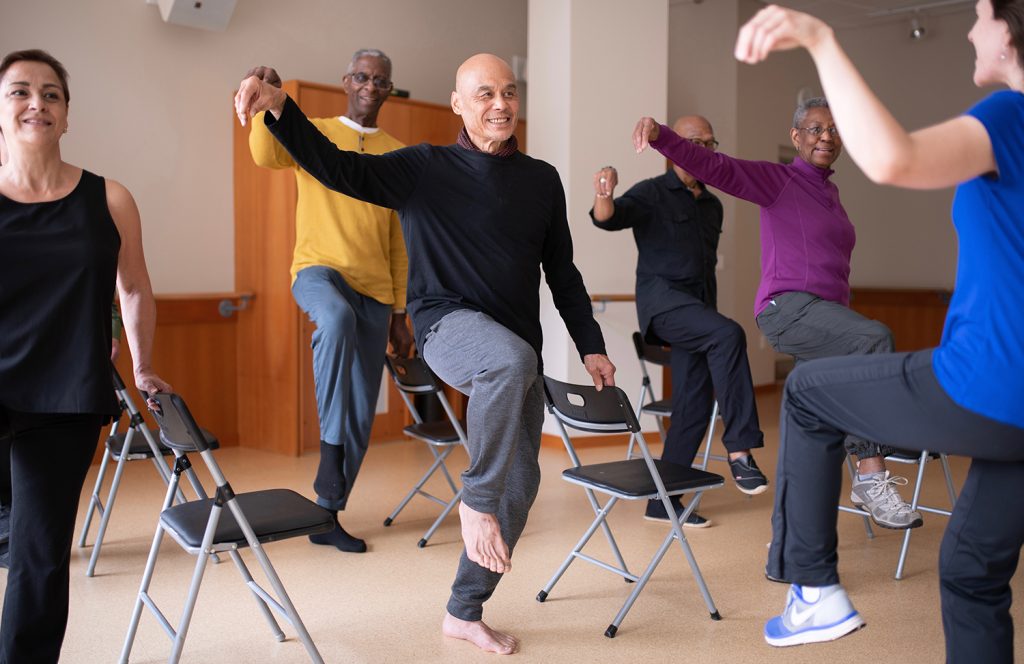Research on Tai Chi Prime published in The Gerontologist, a high-ranking peer reviewed journal
Results
Research on Tai Chi Prime indicates that community-dwelling adults 65 and over had significant improvement in balance, cognitive skills, strength and mobility in just 6 weeks. The researchers believe that the program’s home practice component was essential to its success in that practicing outside of class helps reinforce learning.
BALANCE
Tai Chi Prime features instruction in the Tai Chi Fundamentals® (TCF) Adapted Program, which teaches tai chi in a simple-to-complex progression to foster success in learning movement. Each class features instruction in TCF Basic Moves, building blocks for learning tai chi, and the TCF Short Form, which is based in traditional tai chi. A growing body of research indicates that tai chi is an excellent practice for improving balance.
COGNITIVE SKILLS
Tai Chi Prime integrates Mind/Body Skills into all aspects of teaching to improve mental focus and body awareness. Participants learn to relax, breathe deeply and bring awareness into the present moment to become more receptive to their body’s signals and to what is going on around them. This deeper sense of presence can enhance cognitive skills plus zest for life and rapport with others.
STRENGTH AND MOBILITY
Participants also demonstrated significant improvement in getting up from a chair, as well as walking and turning around speed.

Science Description
Chewning B, Hallisy KM, Mahoney JE, Wilson D, Sangasubana N, Gangnon R. Disseminating Tai Chi in the Community: Promoting Home Practice and Improving Balance Gerontologist. 2019 Feb 27. pii: gnz006
The 6-week Tai Chi Prime (TCP) course was evaluated in a 3-city, randomized trial with 197 community dwelling adults aged 65 years and older. The study aim was to reduce participants’ fall risks while refining key elements of the dissemination and implementation of the course. To meet these aims, the team designed TCP as a short course augmented by home practice. To promote home practice, participants developed and wrote a personal daily home practice plan on a “planner” and then tracked their practice adherence on a “tracker” twice during the course, bringing their trackers back to class for problem-solving and supportive discussion. Participants learned to fit practicing a brief set of Fab Four moves into usual daily habits, such as when making coffee.
Results
Results of the trial were positive for falls risk outcomes and self-reported home practice. Course impact on falls risk scores was significantly better for the TCP participants than for the control group. Using validated falls risk indicators recommended by the Centers for Disease Control, TCP participants had significantly better STEADI measure scores for leg strength, tandem stance balance, and mobility and gait.
In addition, balance confidence and executive function were significantly better for the TCP participants than the control group. Further, participants reported they practiced an average of 6 days out of 7 for 26 minutes per day. Program implementation resulted in large class sizes, strong participant retention, and high observed fidelity of course delivery by teachers.
History with CAARN
The Community Academic Aging Research Network (CAARN) facilitated the Tai Chi Prime research by identifying community sites interested in tai chi. They helped the research team identify possible Area Offices on Aging in Lacrosse, Milwaukee and Madison who had strong community center coordinators to partner offering Tai Chi Prime classes. CAARN staff, center program coordinators and the research team had regular bimonthly phone conference calls to address decisions about study design issues, recruitment and enrollment of older adults, and space needs for both the courses and data collection.
